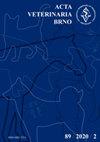与宠物同住一个家对人类微生物组生理状态的影响:一项对捷克人口的综合研究,重点是丝状真菌
IF 0.7
4区 农林科学
Q3 VETERINARY SCIENCES
引用次数: 0
摘要
捷克人通常和宠物动物住在一起。然而,丝状真菌(FF)在宠物和主人之间传播的可能性尚不清楚。这项研究的目的是确定这种传播的频率。同时,定义了饲养人与动物的亲密程度、对共享FF谱的影响以及健康风险评价。还评估了既往抗生素治疗对真菌菌群的影响。来自125户家庭的150名宠物主人和135只宠物动物共提供了911份样本;80名非业主提供了320份样品。所有的主人都完成了一份调查问卷,重点是与宠物的接触程度以及以前的抗生素治疗信息。量化接触指数(CI)与既往抗生素治疗对FF共有菌种数量的影响之间的关系。将结果与非所有者的结果进行比较。131名业主(87.3%)的CI非常接近(CI bb0.4)。共分离FF 110株。常见FF 42户(33.6%);在非业主中确定了65个FF。去年,46只宠物,43名主人和25名非主人使用了抗菌剂。黑曲霉在主人和宠物中最普遍,而在非主人中交替霉属最普遍。接触亲密程度似乎对FF的关节丰度没有任何影响,但抗生素治疗对非所有者的FF丰度有显著影响。这种影响在主人和宠物身上都不明显。本文章由计算机程序翻译,如有差异,请以英文原文为准。
The impact of sharing a home with a pet on the physiological state of the human microbiome: a comprehensive study on the Czech population with a focus on filamentous fungi
Czechs commonly share their homes with pet animals. However, the likelihood of transmission of filamentous fungi (FF) between the pet and the owner is not well known. The aim of this study was to define the frequency of such transmission. At the same time, the degree of closeness of owner-animal cohabitation, the effect on the spectrum of shared FF and health risk assessment were defined. The effect of previous antibiotic therapy on fungal flora was also assessed. In total, 150 pet owners and 135 pet animals from 125 households provided 911 samples; 80 non-owners provided 320 samples. All owners completed a questionnaire focusing on the level of contact with the pet and information on previous antibiotic treatment. The relationship between the contact index (CI) and the effect of previous antibiotic treatment on the number of FF species shared was quantified. Results were compared with those of non-owners. The CI was very close (CI > 4) in 131 owners (87.3%). A total of 110 FF were isolated. Common FF were found in 42 households (33.6%); 65 FF were identified in the non-owners. In the last year, 46 pets, 43 owners and 25 non-owners used antimicrobial agents. Aspergillus niger was most prevalent in owners and pets and Alternaria alternata in non-owners. The degree of contact intimacy did not seem to have any effect on the joint abundance of FF, but antibiotic treatment had a significant effect on FF abundance in non-owners. This effect was not significant in either owners or pets.
求助全文
通过发布文献求助,成功后即可免费获取论文全文。
去求助
来源期刊

Acta Veterinaria Brno
农林科学-兽医学
CiteScore
1.00
自引率
33.30%
发文量
36
审稿时长
18-36 weeks
期刊介绍:
ACTA VETERINARIA BRNO is a scientific journal of the University of Veterinary and Pharmaceutical Sciences in Brno, Czech Republic.
The scientific journal Acta Veterinaria Brno is dedicated to the publication of original research findings and clinical observations in veterinary and biomedical sciences. Original scientific research articles reporting new and substantial contribution to veterinary science and original methods that have not been submitted for publication elsewhere are considered for publication. A written statement to this effect should accompany the manuscript, along with approval for publication by the author´s head of department. The authors bear full responsibility for the contents of their contribution. Book reviews are published, too.
 求助内容:
求助内容: 应助结果提醒方式:
应助结果提醒方式:


